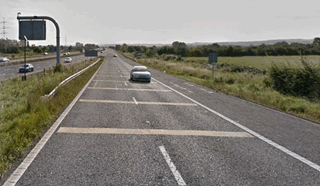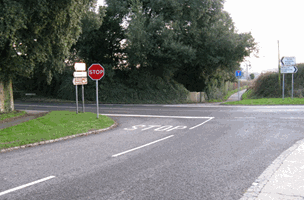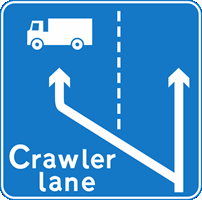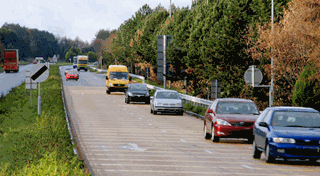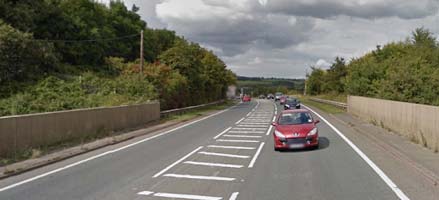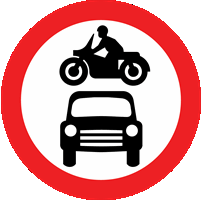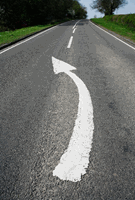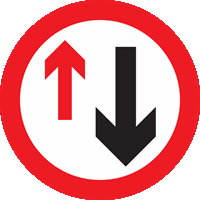The duration of this ADI theory test is 90 minutes (1 hour 30 minutes). There are 100 multiple choice questions. You need at least 85/100 to pass. Click the Begin Test button when you're ready to start. You may review your answer after each question or wait until the end to view your overall result. Good luck!
Test Quick View
Click on an answer to view the correct choice along with the explanation.
Correct Answer: D
Explanation: These lines are a device often found on the approach to a roundabout or a dangerous junction. They become closer together as you approach the hazard, warning you to slow down.
Explanation: These lines are a device often found on the approach to a roundabout or a dangerous junction. They become closer together as you approach the hazard, warning you to slow down.
Correct Answer: C
Explanation: Puffin crossings have infra-red sensors that detect when pedestrians are crossing and hold the red traffic signal until the crossing is clear. The use of a sensor means there's no flashing amber phase, as there is with a pelican crossing; the lights follow the same sequence as traffic lights.
Explanation: Puffin crossings have infra-red sensors that detect when pedestrians are crossing and hold the red traffic signal until the crossing is clear. The use of a sensor means there's no flashing amber phase, as there is with a pelican crossing; the lights follow the same sequence as traffic lights.
3. How should you react when you see an ambulance with flashing blue lights behind you?
Mark one answer
B
C
D
Correct Answer: B
Explanation: When an emergency vehicle is behind with its blue lights flashing, you must remain calm and look ahead for a safe place to move over to let it pass. If you're waiting at red traffic lights, don't attempt to clear the way by driving past the red light; this is both dangerous and a traffic offence.
Explanation: When an emergency vehicle is behind with its blue lights flashing, you must remain calm and look ahead for a safe place to move over to let it pass. If you're waiting at red traffic lights, don't attempt to clear the way by driving past the red light; this is both dangerous and a traffic offence.
Correct Answer: A
Explanation: You mustn't use a vehicle's horn between 11.30 pm and 7.00 am in a built-up area or when the vehicle is stationary, unless another moving vehicle poses a danger. The horn should be used to alert other road users to your presence.
Explanation: You mustn't use a vehicle's horn between 11.30 pm and 7.00 am in a built-up area or when the vehicle is stationary, unless another moving vehicle poses a danger. The horn should be used to alert other road users to your presence.
Correct Answer: A
Explanation: At blind junctions, there's often a 'stop' sign. The 'stop' sign has been put there because the view into the main road is poor. You must stop because it won't be possible to assess the situation on the move, however slowly you're travelling.
Explanation: At blind junctions, there's often a 'stop' sign. The 'stop' sign has been put there because the view into the main road is poor. You must stop because it won't be possible to assess the situation on the move, however slowly you're travelling.
B
C
D
Correct Answer: B
Explanation: A motorcycle can be lost from sight behind another vehicle. The use of the headlight helps to make it more conspicuous and therefore more easily seen.
Explanation: A motorcycle can be lost from sight behind another vehicle. The use of the headlight helps to make it more conspicuous and therefore more easily seen.
7. Why might a motorcyclist glance back over their right shoulder before turning right?
Mark one answer
B
C
D
Correct Answer: B
Explanation: If you see a motorcyclist take a quick glance over their shoulder, this could mean they're about to change direction. Recognising a clue like this helps you to be prepared and take appropriate action, making you safer on the road.
Explanation: If you see a motorcyclist take a quick glance over their shoulder, this could mean they're about to change direction. Recognising a clue like this helps you to be prepared and take appropriate action, making you safer on the road.
Correct Answer: A
Explanation: Motorcyclists will be checking the road ahead for uneven or slippery surfaces, especially in wet weather. They may need to move across their lane to avoid road-surface hazards such as potholes and slippery metal drain covers.
Explanation: Motorcyclists will be checking the road ahead for uneven or slippery surfaces, especially in wet weather. They may need to move across their lane to avoid road-surface hazards such as potholes and slippery metal drain covers.
Correct Answer: A
Explanation: It takes more time to overtake a long vehicle than a small one, such as a car. Before overtaking, you need to be able to see far enough ahead to know that you have the space and time to complete the manoeuvre safely. Hazards to watch for include oncoming traffic, junctions, bends or dips (which could restrict your view), and any signs or road markings prohibiting overtaking.
Explanation: It takes more time to overtake a long vehicle than a small one, such as a car. Before overtaking, you need to be able to see far enough ahead to know that you have the space and time to complete the manoeuvre safely. Hazards to watch for include oncoming traffic, junctions, bends or dips (which could restrict your view), and any signs or road markings prohibiting overtaking.
Correct Answer: A
Explanation: On a motorway, all traffic should use the left-hand lane unless overtaking. When overtaking a number of slower vehicles, move back to the left-hand lane when you're safely past. Check your mirrors frequently and don't stay in the middle or right-hand lane if the left-hand lane is free.
Explanation: On a motorway, all traffic should use the left-hand lane unless overtaking. When overtaking a number of slower vehicles, move back to the left-hand lane when you're safely past. Check your mirrors frequently and don't stay in the middle or right-hand lane if the left-hand lane is free.
Correct Answer: D
Explanation: You should keep to the left and only use the centre or right-hand lanes if you're passing slower-moving traffic.
Explanation: You should keep to the left and only use the centre or right-hand lanes if you're passing slower-moving traffic.
12. On a motorway, why might it be better to use an emergency roadside telephone rather than a mobile phone?
Mark one answer
B
C
D
Correct Answer: A
Explanation: On a motorway, it's best to use a roadside emergency telephone so that the emergency services are able to locate you easily. The nearest telephone is indicated by an arrow on marker posts, which are placed every 100 metres along the edge of the hard shoulder. If you do use a mobile phone, the emergency services will want to know your exact location. Before you call, find out the number on the nearest marker post; this will tell the emergency services your exact location.
Explanation: On a motorway, it's best to use a roadside emergency telephone so that the emergency services are able to locate you easily. The nearest telephone is indicated by an arrow on marker posts, which are placed every 100 metres along the edge of the hard shoulder. If you do use a mobile phone, the emergency services will want to know your exact location. Before you call, find out the number on the nearest marker post; this will tell the emergency services your exact location.
Correct Answer: C
Explanation: Large, slow-moving vehicles can hinder the progress of other traffic. On a steep gradient, an extra crawler lane may be provided for slow-moving vehicles to allow faster-moving traffic to flow more easily.
Explanation: Large, slow-moving vehicles can hinder the progress of other traffic. On a steep gradient, an extra crawler lane may be provided for slow-moving vehicles to allow faster-moving traffic to flow more easily.
Correct Answer: A
Explanation: There's usually a 30 mph speed limit where street lights are less than 185 metres (600 feet) apart.
Explanation: There's usually a 30 mph speed limit where street lights are less than 185 metres (600 feet) apart.
Correct Answer: C
Explanation: Look at each sign that you pass on the road, so that you don't miss any warnings, orders or information. The shape of the sign will tell you its purpose: triangular signs warn, circles give orders and rectangles inform.
Explanation: Look at each sign that you pass on the road, so that you don't miss any warnings, orders or information. The shape of the sign will tell you its purpose: triangular signs warn, circles give orders and rectangles inform.
B
C
D
Correct Answer: D
Explanation: As you approach traffic lights that have been on green for some time, anticipate that they'll soon change. Check your mirror so that you know what traffic is behind you and how far away it is. If the lights change to steady amber, you should stop behind the stop line. If you're so close to the stop line when the lights change that to stop may cause a collision, you should continue. You'll only know the risk from traffic behind if you use your mirrors as you approach the lights.
Explanation: As you approach traffic lights that have been on green for some time, anticipate that they'll soon change. Check your mirror so that you know what traffic is behind you and how far away it is. If the lights change to steady amber, you should stop behind the stop line. If you're so close to the stop line when the lights change that to stop may cause a collision, you should continue. You'll only know the risk from traffic behind if you use your mirrors as you approach the lights.
Correct Answer: A
Explanation: When traffic lights are out of order, you should treat the junction as an unmarked crossroads. Be cautious, as you may need to give way or stop. Look for traffic attempting to cross the junction, unaware that it doesn't have priority.
Explanation: When traffic lights are out of order, you should treat the junction as an unmarked crossroads. Be cautious, as you may need to give way or stop. Look for traffic attempting to cross the junction, unaware that it doesn't have priority.
18. In which of these circumstances is it permitted to cross the solid double white lines in the middle of the road?
Mark one answer
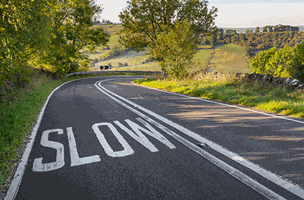
B
C
D
Correct Answer: C
Explanation: You may cross the solid white line to pass a stationary vehicle or to pass a pedal cycle, horse or road maintenance vehicle if it's travelling at 10 mph or less. You may also cross the solid white line to enter a side road or access a property.
Explanation: You may cross the solid white line to pass a stationary vehicle or to pass a pedal cycle, horse or road maintenance vehicle if it's travelling at 10 mph or less. You may also cross the solid white line to enter a side road or access a property.
Correct Answer: C
Explanation: You should normally overtake on the right, but there are some occasions when you may overtake on the left. These include when you're driving on a dual carriageway or motorway and the traffic is moving slowly in queues, or when a vehicle ahead is positioned to turn right and there's room to pass on the left. On dual carriageways or motorways, don't overtake on the left if traffic is flowing freely.
Explanation: You should normally overtake on the right, but there are some occasions when you may overtake on the left. These include when you're driving on a dual carriageway or motorway and the traffic is moving slowly in queues, or when a vehicle ahead is positioned to turn right and there's room to pass on the left. On dual carriageways or motorways, don't overtake on the left if traffic is flowing freely.
Correct Answer: A
Explanation: A convex mirror gives a wide view of the scene behind. However, it won't show you everything behind, or to the side of, your vehicle. Before you move off, look over your shoulder to check for anything that's not visible in the mirrors.
Explanation: A convex mirror gives a wide view of the scene behind. However, it won't show you everything behind, or to the side of, your vehicle. Before you move off, look over your shoulder to check for anything that's not visible in the mirrors.
Correct Answer: B
Explanation: Potholes and bumps in the road can unbalance a motorcyclist. For this reason, a rider may swerve to avoid an uneven road surface. Knowing what motorcyclists may do will help you to make allowances for them.
Explanation: Potholes and bumps in the road can unbalance a motorcyclist. For this reason, a rider may swerve to avoid an uneven road surface. Knowing what motorcyclists may do will help you to make allowances for them.
22. How should you behave if the vehicle in front of you is being driven by an elderly person?
Mark one answer
B
C
D
Correct Answer: A
Explanation: You must show consideration to other road users. The reactions of elderly drivers may be slower and they might need more time to deal with a situation. Be tolerant and don't lose patience or show your annoyance.
Explanation: You must show consideration to other road users. The reactions of elderly drivers may be slower and they might need more time to deal with a situation. Be tolerant and don't lose patience or show your annoyance.
Correct Answer: C
Explanation: To prevent your headlights from dazzling the driver of the car in front, wait until you've overtaken before switching to full beam.
Explanation: To prevent your headlights from dazzling the driver of the car in front, wait until you've overtaken before switching to full beam.
Correct Answer: D
Explanation: If your tyre pressures are lower than those recommended by the manufacturer, there will be increased rolling resistance. To overcome this, the engine will have to work harder, resulting in increased fuel consumption. Check your tyre pressures at least once a week.
Explanation: If your tyre pressures are lower than those recommended by the manufacturer, there will be increased rolling resistance. To overcome this, the engine will have to work harder, resulting in increased fuel consumption. Check your tyre pressures at least once a week.
Correct Answer: C
Explanation: After driving at motorway speeds for some time, a driver's judgement of speed may be affected. Having left a motorway, it's important that drivers frequently check their speedometer to avoid driving faster than they realise.
Explanation: After driving at motorway speeds for some time, a driver's judgement of speed may be affected. Having left a motorway, it's important that drivers frequently check their speedometer to avoid driving faster than they realise.
Correct Answer: C
Explanation: In traffic, cyclists often filter past on the left of slow-moving queues or stationary vehicles. Before making a left turn, you should check your nearside and, if necessary, hold back until you can turn without cutting across a filtering cyclist.
Explanation: In traffic, cyclists often filter past on the left of slow-moving queues or stationary vehicles. Before making a left turn, you should check your nearside and, if necessary, hold back until you can turn without cutting across a filtering cyclist.
27. What should you do if you see this sign on a motorway while driving in the right-hand lane?
Mark one answer

B
C
D
Correct Answer: C
Explanation: This sign on the overhead gantry will be accompanied by flashing amber lights. The arrow directs you to move into the next lane. There might not be any visible signs of a problem ahead, but there might be queuing traffic or another hazard that you can't yet see.
Explanation: This sign on the overhead gantry will be accompanied by flashing amber lights. The arrow directs you to move into the next lane. There might not be any visible signs of a problem ahead, but there might be queuing traffic or another hazard that you can't yet see.
28. What must be removed from a car fitted with dual accelerator, brakes and clutch pedals before it can be used to take a driving test?
Mark one answer
B
C
D
Correct Answer: A
Explanation: Dual accelerators aren't normally fitted to training vehicles. If one is fitted, it must be removed while the vehicle is being used for a driving test.
Explanation: Dual accelerators aren't normally fitted to training vehicles. If one is fitted, it must be removed while the vehicle is being used for a driving test.
Correct Answer: C
Explanation: The extended test takes about 70 minutes and is assessed to the same level as the standard driving test for learner drivers.
Explanation: The extended test takes about 70 minutes and is assessed to the same level as the standard driving test for learner drivers.
Correct Answer: A
Explanation: Taking time to establish a pupil's learning goals and needs provides you with the information you need to make an effective learning plan. It involves the pupil in the planning process, so the final product is something they have agreed to and engaged with.
Explanation: Taking time to establish a pupil's learning goals and needs provides you with the information you need to make an effective learning plan. It involves the pupil in the planning process, so the final product is something they have agreed to and engaged with.
Correct Answer: A
Explanation: Learning isn't always a continuous process. Sometimes pupils simply need time to consolidate learning before moving on. On other occasions there may be something blocking progress. You should work with the learner to understand what's happening and agree how to move on.
Explanation: Learning isn't always a continuous process. Sometimes pupils simply need time to consolidate learning before moving on. On other occasions there may be something blocking progress. You should work with the learner to understand what's happening and agree how to move on.
Correct Answer: D
Explanation: Some zebra crossings are divided by a central island. Each half is a separate crossing.
Explanation: Some zebra crossings are divided by a central island. Each half is a separate crossing.
Correct Answer: A
Explanation: If air gets into the hydraulic system, the brake pedal will feel spongy. When you press it, the air is compressed, causing the pedal to move further than normal. As a result, braking efficiency is reduced. Have the system checked by a qualified mechanic: brake faults are too important to be ignored.
Explanation: If air gets into the hydraulic system, the brake pedal will feel spongy. When you press it, the air is compressed, causing the pedal to move further than normal. As a result, braking efficiency is reduced. Have the system checked by a qualified mechanic: brake faults are too important to be ignored.
Correct Answer: C
Explanation: In fog, you won't be able to see as far ahead as you can on a clear day. You'll need to reduce your speed so that, if a hazard develops, you have the time and space to take avoiding action. If you can, try to delay your journey until the fog has cleared.
Explanation: In fog, you won't be able to see as far ahead as you can on a clear day. You'll need to reduce your speed so that, if a hazard develops, you have the time and space to take avoiding action. If you can, try to delay your journey until the fog has cleared.
Correct Answer: D
Explanation: Parking near a pedestrian crossing creates an obstruction that prevents both drivers and pedestrians from having a clear view. Careless parking is selfish and could endanger other road users.
Explanation: Parking near a pedestrian crossing creates an obstruction that prevents both drivers and pedestrians from having a clear view. Careless parking is selfish and could endanger other road users.
36. How should you react if another vehicle is trying to overtake you but is taking a long time to do so?
Mark one answer
B
C
D
Correct Answer: C
Explanation: If a vehicle is taking a long time to overtake, you should try to help the situation by slowing down. Your safety and the safety of other road users could be at risk if you maintain speed and prolong the time it takes for the overtaking manoeuvre to be completed.
Explanation: If a vehicle is taking a long time to overtake, you should try to help the situation by slowing down. Your safety and the safety of other road users could be at risk if you maintain speed and prolong the time it takes for the overtaking manoeuvre to be completed.
Correct Answer: B
Explanation: By leaving the car in gear, the engine will help to prevent the vehicle from rolling. When parking facing uphill, select first gear. This will maximise the resistance from the engine if the parking brake should fail.
Explanation: By leaving the car in gear, the engine will help to prevent the vehicle from rolling. When parking facing uphill, select first gear. This will maximise the resistance from the engine if the parking brake should fail.
Correct Answer: D
Explanation: Usually, a road is constructed with a camber: the road surface slopes to assist with drainage. Some bends have an 'adverse camber'. This is where the road slopes towards the outside of the bend. When going around a bend that has adverse camber, you need to take extra care. The forces acting on your vehicle could cause it to leave the road more easily than normal.
Explanation: Usually, a road is constructed with a camber: the road surface slopes to assist with drainage. Some bends have an 'adverse camber'. This is where the road slopes towards the outside of the bend. When going around a bend that has adverse camber, you need to take extra care. The forces acting on your vehicle could cause it to leave the road more easily than normal.
Correct Answer: A
Explanation: An MOT certificate will normally be valid for one year. The certificate doesn't warrant the condition of the vehicle at a later date, but simply shows that at the time the certificate was issued the vehicle met the MOT requirements. It's the driver's responsibility to ensure that the vehicle is roadworthy whenever it's driven.
Explanation: An MOT certificate will normally be valid for one year. The certificate doesn't warrant the condition of the vehicle at a later date, but simply shows that at the time the certificate was issued the vehicle met the MOT requirements. It's the driver's responsibility to ensure that the vehicle is roadworthy whenever it's driven.
Correct Answer: C
Explanation: The ignition light should go out once the engine has started. If it comes on during normal driving, this would indicate a fault with the charging system. Have it checked.
Explanation: The ignition light should go out once the engine has started. If it comes on during normal driving, this would indicate a fault with the charging system. Have it checked.
B
C
D
Correct Answer: C
Explanation: Dual carriageways and motorways share the same 70 mph national speed limit for cars and motorcycles. If a car or motorcycle is towing a trailer, then this maximum permitted speed is reduced to 60 mph.
Explanation: Dual carriageways and motorways share the same 70 mph national speed limit for cars and motorcycles. If a car or motorcycle is towing a trailer, then this maximum permitted speed is reduced to 60 mph.
Correct Answer: C
Explanation: Check the tyre pressures when the tyres are cold. Warm or hot tyres may give a misleading reading.
Explanation: Check the tyre pressures when the tyres are cold. Warm or hot tyres may give a misleading reading.
Correct Answer: B
Explanation: To design an effective programme of learning, it's important to understand what a pupil brings to the process. This will enable you to decide the level at which instruction can begin. It will also encourage the pupil to engage with the learning process if they're not forced to go over material they already know.
Explanation: To design an effective programme of learning, it's important to understand what a pupil brings to the process. This will enable you to decide the level at which instruction can begin. It will also encourage the pupil to engage with the learning process if they're not forced to go over material they already know.
Correct Answer: B
Explanation: When planning and delivering a lesson, it's important to remember that we all learn in different ways. Continuing to deliver in the same way, when the pupil is clearly not engaging or making progress, may reduce their motivation even further.
Explanation: When planning and delivering a lesson, it's important to remember that we all learn in different ways. Continuing to deliver in the same way, when the pupil is clearly not engaging or making progress, may reduce their motivation even further.
45. What should you do if you're being tailgated by a vehicle in the right-hand lane of a two-lane motorway?
Mark one answer
B
C
D
Correct Answer: C
Explanation: When you're overtaking on a motorway, you'll sometimes find faster vehicles approaching from behind. When it's safe to do so, you should move over and let them pass. Don't try to enforce the legal speed limit.
Explanation: When you're overtaking on a motorway, you'll sometimes find faster vehicles approaching from behind. When it's safe to do so, you should move over and let them pass. Don't try to enforce the legal speed limit.
46. When parking an automatic car on a hill, what position should you move the gear selector into before leaving the vehicle?
Mark one answer
B
C
D
Correct Answer: C
Explanation: When parking a vehicle with automatic transmission, the gear selector should be moved to the 'P' (Park) position. This locks the transmission and prevents the vehicle from moving forwards or backwards. This will stop it from rolling away should the parking brake fail.
Explanation: When parking a vehicle with automatic transmission, the gear selector should be moved to the 'P' (Park) position. This locks the transmission and prevents the vehicle from moving forwards or backwards. This will stop it from rolling away should the parking brake fail.
Correct Answer: A
Explanation: It's recommended that you check all the lights on your vehicle on a daily basis and replace any faulty bulbs. Carrying spare bulbs and fuses in your vehicle will ensure you can replace a bulb as soon as you find it has failed.
Explanation: It's recommended that you check all the lights on your vehicle on a daily basis and replace any faulty bulbs. Carrying spare bulbs and fuses in your vehicle will ensure you can replace a bulb as soon as you find it has failed.
48. What happens if a candidate doesn't meet the eyesight requirements at start of a driving test?
Mark one answer
B
C
D
Correct Answer: C
Explanation: The eyesight test is carried out at the start of the practical driving test. If a candidate can't meet the eyesight requirements, they'll fail the test and it won't continue any further.
Explanation: The eyesight test is carried out at the start of the practical driving test. If a candidate can't meet the eyesight requirements, they'll fail the test and it won't continue any further.
49. What should a candidate do when given the emergency stop signal by the examiner?
Mark one answer
B
C
D
Correct Answer: A
Explanation: During an emergency-stop exercise, the examiner will check that the road is clear behind before they give the signal to stop. At the signal, the candidate should keep full control of the vehicle while stopping it as quickly and safely as possible.
Explanation: During an emergency-stop exercise, the examiner will check that the road is clear behind before they give the signal to stop. At the signal, the candidate should keep full control of the vehicle while stopping it as quickly and safely as possible.
Correct Answer: C
Explanation: The national speed limit for a car or motorcycle on a single carriageway is 60 mph. You don't have to drive at the speed limit. Use your judgement and keep within the speed limit while driving at a speed that suits the road, weather and traffic conditions.
Explanation: The national speed limit for a car or motorcycle on a single carriageway is 60 mph. You don't have to drive at the speed limit. Use your judgement and keep within the speed limit while driving at a speed that suits the road, weather and traffic conditions.
Correct Answer: B
Explanation: You may use hazard warning lights when you slow suddenly on a motorway or unrestricted dual carriageway, to warn traffic behind of a hazard ahead. Never use hazard warning lights to excuse dangerous or illegal parking.
Explanation: You may use hazard warning lights when you slow suddenly on a motorway or unrestricted dual carriageway, to warn traffic behind of a hazard ahead. Never use hazard warning lights to excuse dangerous or illegal parking.
B
C
D
Correct Answer: A
Explanation: There are times when other drivers make incorrect or ill-judged decisions. Stay calm and don't retaliate or react aggressively. Always consider the safety of other road users, your passengers and yourself.
Explanation: There are times when other drivers make incorrect or ill-judged decisions. Stay calm and don't retaliate or react aggressively. Always consider the safety of other road users, your passengers and yourself.
53. What should you do if the driver behind you is driving in an aggressive manner and trying to overtake you?
Mark one answer
B
C
D
Correct Answer: A
Explanation: Never obstruct drivers who wish to pass. Speeding up or driving unpredictably while someone is overtaking you is dangerous. If someone overtakes and pulls into the gap in front of you, drop back to maintain a two-second gap.
Explanation: Never obstruct drivers who wish to pass. Speeding up or driving unpredictably while someone is overtaking you is dangerous. If someone overtakes and pulls into the gap in front of you, drop back to maintain a two-second gap.
Correct Answer: B
Explanation: Don't ignore feelings of drowsiness while driving. You'll need to find somewhere safe to stop and rest until you feel alert enough to continue your journey. On a motorway, you can either stop at a service area or leave the motorway and then find a safe place to stop. Until you reach a safe place to stop, make sure the vehicle is well ventilated. Don't stop on the hard shoulder to rest.
Explanation: Don't ignore feelings of drowsiness while driving. You'll need to find somewhere safe to stop and rest until you feel alert enough to continue your journey. On a motorway, you can either stop at a service area or leave the motorway and then find a safe place to stop. Until you reach a safe place to stop, make sure the vehicle is well ventilated. Don't stop on the hard shoulder to rest.
55. What should you do if you see a pedestrian crossing the road that you're reversing into?
Mark one answer
B
C
D
Correct Answer: D
Explanation: If you're reversing into a side road and see a pedestrian crossing the road behind your vehicle, wait until the pedestrian has passed before continuing. Don't forget that you may not be able to see a small child directly behind your vehicle. Be aware of the possibility of hidden dangers.
Explanation: If you're reversing into a side road and see a pedestrian crossing the road behind your vehicle, wait until the pedestrian has passed before continuing. Don't forget that you may not be able to see a small child directly behind your vehicle. Be aware of the possibility of hidden dangers.
56. Why should you check the driver side mirror just before turning right into a side road?
Mark one answer
B
C
D
Correct Answer: B
Explanation: In queuing traffic, motorcyclists and cyclists often filter past the stationary vehicles. Before you turn right in a traffic queue, check your mirrors for passing vehicles. Motorcyclists and cyclists are smaller than other vehicles and can be difficult to see, so look for them before turning.
Explanation: In queuing traffic, motorcyclists and cyclists often filter past the stationary vehicles. Before you turn right in a traffic queue, check your mirrors for passing vehicles. Motorcyclists and cyclists are smaller than other vehicles and can be difficult to see, so look for them before turning.
Correct Answer: B
Explanation: On a motorway, you should keep to the left-hand lane whenever possible. Only use the other lanes for overtaking or when directed by signals. Using other lanes when the left-hand lane is empty can frustrate drivers behind you.
Explanation: On a motorway, you should keep to the left-hand lane whenever possible. Only use the other lanes for overtaking or when directed by signals. Using other lanes when the left-hand lane is empty can frustrate drivers behind you.
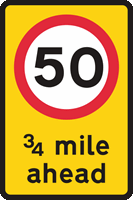
B
C
D
Correct Answer: A
Explanation: A circular sign with a red border tells you what you mustn't do. If the circle contains a speed limit, you mustn't exceed the limit, whether the sign is temporary or not.
Explanation: A circular sign with a red border tells you what you mustn't do. If the circle contains a speed limit, you mustn't exceed the limit, whether the sign is temporary or not.
59. What should you do if you see warning lights and hear bells ringing while driving over a level crossing?
Mark one answer
B
C
D
Correct Answer: A
Explanation: If the amber warning lights come on as you're approaching the crossing, you must stop unless it's unsafe to do so. Red flashing lights together with an audible signal mean you must stop. If the warning lights and alarm start as you're driving over the crossing, continue and clear the crossing; it would be dangerous to stop at that point.
Explanation: If the amber warning lights come on as you're approaching the crossing, you must stop unless it's unsafe to do so. Red flashing lights together with an audible signal mean you must stop. If the warning lights and alarm start as you're driving over the crossing, continue and clear the crossing; it would be dangerous to stop at that point.
Correct Answer: D
Explanation: Driving a vehicle without insurance cover is illegal. If you cause injury to anyone or damage their property, it could be very expensive and you could also be subject to criminal prosecution.
Explanation: Driving a vehicle without insurance cover is illegal. If you cause injury to anyone or damage their property, it could be very expensive and you could also be subject to criminal prosecution.
B
C
D
Correct Answer: B
Explanation: If you don't have your vehicle serviced regularly, the engine will steadily become less efficient. This loss of efficiency will progressively cause an increase in fuel consumption, engine running problems and increased risk of the vehicle breaking down.
Explanation: If you don't have your vehicle serviced regularly, the engine will steadily become less efficient. This loss of efficiency will progressively cause an increase in fuel consumption, engine running problems and increased risk of the vehicle breaking down.
62. Why should you take extra care to prevent spillage when refuelling a diesel car?
Mark one answer
B
C
D
Correct Answer: D
Explanation: The diesel you use to run a vehicle is a form of oil and, as such, is very slippery when spilt on the road. The usual places to find diesel spillage are near filling stations and on bends or roundabouts. Overfilled fuel tanks and poorly fitting or missing fuel filler caps are often the cause of diesel spillage, so make sure you replace your fuel filler cap securely after refuelling.
Explanation: The diesel you use to run a vehicle is a form of oil and, as such, is very slippery when spilt on the road. The usual places to find diesel spillage are near filling stations and on bends or roundabouts. Overfilled fuel tanks and poorly fitting or missing fuel filler caps are often the cause of diesel spillage, so make sure you replace your fuel filler cap securely after refuelling.
Correct Answer: D
Explanation: In very wet weather, water can build up between the tyre and the road surface. As a result, your vehicle rides on a thin film of water and your tyres won't grip the road. Gravel or shingle surfaces also offer less grip and can cause problems when braking. An anti-lock braking system may be ineffective in these conditions.
Explanation: In very wet weather, water can build up between the tyre and the road surface. As a result, your vehicle rides on a thin film of water and your tyres won't grip the road. Gravel or shingle surfaces also offer less grip and can cause problems when braking. An anti-lock braking system may be ineffective in these conditions.
64. What should you do if your front fog lights are switched on but conditions are clear?
Mark one answer
B
C
D
Correct Answer: C
Explanation: Fog lights should only be used when visibility is seriously reduced. They must be switched off when visibility improves, to avoid dazzling other road users.
Explanation: Fog lights should only be used when visibility is seriously reduced. They must be switched off when visibility improves, to avoid dazzling other road users.
65. Why is it potentially dangerous to leave rear fog lights switched on when they're not required?
Mark one answer
B
C
D
Correct Answer: B
Explanation: If you don't switch off rear fog lights when the fog has lifted, drivers behind may find it difficult to see your brake lights. This can be a particular problem on wet roads and on motorways. If you leave your rear fog lights on at night, drivers behind are likely to be dazzled and this could put you both at risk.
Explanation: If you don't switch off rear fog lights when the fog has lifted, drivers behind may find it difficult to see your brake lights. This can be a particular problem on wet roads and on motorways. If you leave your rear fog lights on at night, drivers behind are likely to be dazzled and this could put you both at risk.
66. In which of these situations might you inflate your tyres beyond the recommended pressure?
Mark one answer
B
C
D
Correct Answer: A
Explanation: Check the vehicle handbook: this should give you guidance on the correct tyre pressures for your vehicle. There may be recommendations to increase the tyre pressure when carrying heavy loads or when travelling continuously at higher speeds, such as when using a motorway.
Explanation: Check the vehicle handbook: this should give you guidance on the correct tyre pressures for your vehicle. There may be recommendations to increase the tyre pressure when carrying heavy loads or when travelling continuously at higher speeds, such as when using a motorway.
Correct Answer: A
Explanation: When there's reduced grip (for example, when there's wet mud, snow or ice on the road), drive in a high gear. The engine then drives the wheels with less torque than if you were using a low gear, and this reduces the likelihood of wheelspin.
Explanation: When there's reduced grip (for example, when there's wet mud, snow or ice on the road), drive in a high gear. The engine then drives the wheels with less torque than if you were using a low gear, and this reduces the likelihood of wheelspin.
68. How should you react to a long lorry emerging from a junction up ahead to your right?
Mark one answer
B
C
D
Correct Answer: A
Explanation: Sometimes, large vehicles may need more space than other road users. If a vehicle needs more time and space to turn, be prepared to stop and wait.
Explanation: Sometimes, large vehicles may need more space than other road users. If a vehicle needs more time and space to turn, be prepared to stop and wait.
69. Why might it be dangerous to keep the clutch depressed or the gear in neutral for too long when driving down a steep hill?
Mark one answer
B
C
D
Correct Answer: C
Explanation: Driving in neutral or with the clutch down for long periods is known as 'coasting'. If you do this on a steep downhill gradient, there will be no engine braking to help check your speed.
Explanation: Driving in neutral or with the clutch down for long periods is known as 'coasting'. If you do this on a steep downhill gradient, there will be no engine braking to help check your speed.
70. If you've been given medicine by a doctor, why should enquire about how it will affect you when driving?
Mark one answer
B
C
D
Correct Answer: C
Explanation: Always check the label on any medication you take, as some medicine can make you feel drowsy and slow your reactions. Your doctor or pharmacist will be able to give you advice about possible side-effects of both prescribed and over-the-counter medicines.
Explanation: Always check the label on any medication you take, as some medicine can make you feel drowsy and slow your reactions. Your doctor or pharmacist will be able to give you advice about possible side-effects of both prescribed and over-the-counter medicines.
Correct Answer: B
Explanation: Strict controls on exhaust emissions require a catalytic converter to be fitted to the exhaust system of all new vehicles. Catalytic converters remove most of the carbon monoxide, oxides of nitrogen and unburned hydrocarbons from the exhaust gases.
Explanation: Strict controls on exhaust emissions require a catalytic converter to be fitted to the exhaust system of all new vehicles. Catalytic converters remove most of the carbon monoxide, oxides of nitrogen and unburned hydrocarbons from the exhaust gases.
72. Why should you give motorcyclists ample room when overtaking them in windy conditions?
Mark one answer
B
C
D
Correct Answer: A
Explanation: On a windy day, the blustery conditions will affect motorcyclists and they may be blown off course. If you wish to overtake a motorcyclist in these conditions, make allowances for them and give them extra room.
Explanation: On a windy day, the blustery conditions will affect motorcyclists and they may be blown off course. If you wish to overtake a motorcyclist in these conditions, make allowances for them and give them extra room.
Correct Answer: C
Explanation: A new car in Great Britain doesn't require an MOT test certificate until it's three years old. At all times, it's the driver's responsibility to ensure that the vehicle they're driving is roadworthy.
Explanation: A new car in Great Britain doesn't require an MOT test certificate until it's three years old. At all times, it's the driver's responsibility to ensure that the vehicle they're driving is roadworthy.
Correct Answer: D
Explanation: Carrying a heavy load in a vehicle will change its centre of gravity. This will affect the vehicle's handling on bends, compared with when it's lightly loaded. It's your responsibility to make sure that your vehicle isn't overloaded and that any load is secure.
Explanation: Carrying a heavy load in a vehicle will change its centre of gravity. This will affect the vehicle's handling on bends, compared with when it's lightly loaded. It's your responsibility to make sure that your vehicle isn't overloaded and that any load is secure.
Correct Answer: D
Explanation: Yellow lines are painted across the road on the approach to some roundabouts. The lines are usually found on dual carriageways, where traffic speeds are higher, or at the end of motorway exit slip roads. They provide a visual warning to remind drivers to check their speed.
Explanation: Yellow lines are painted across the road on the approach to some roundabouts. The lines are usually found on dual carriageways, where traffic speeds are higher, or at the end of motorway exit slip roads. They provide a visual warning to remind drivers to check their speed.
Correct Answer: C
Explanation: A primary route is a road of national or regional importance and is the major route between larger towns and cities. The direction signs on these routes have green backgrounds. Many maps and road atlases show these routes in green.
Explanation: A primary route is a road of national or regional importance and is the major route between larger towns and cities. The direction signs on these routes have green backgrounds. Many maps and road atlases show these routes in green.
77. When can trailer towing vehicles use the right-hand lane of a three-lane motorway?
Mark one answer
B
C
D
Correct Answer: C
Explanation: If you're towing a caravan or trailer, you mustn't use the right-hand lane on a motorway with three or more lanes, except in certain circumstances, such as when there are lane closures.
Explanation: If you're towing a caravan or trailer, you mustn't use the right-hand lane on a motorway with three or more lanes, except in certain circumstances, such as when there are lane closures.
Correct Answer: D
Explanation: Seat belts should be worn at all times, unless you're carrying out a manoeuvre that involves reversing. The seat belt should be put back on when you've finished the manoeuvre.
Explanation: Seat belts should be worn at all times, unless you're carrying out a manoeuvre that involves reversing. The seat belt should be put back on when you've finished the manoeuvre.
79. Can you remove your seatbelt while teaching your student to perform a turn in the road?
Mark one answer
B
C
D
Correct Answer: C
Explanation: Drivers and passengers must normally wear seat belts. However, a driver may remove their seat belt when carrying out an exercise that involves reversing; this also applies to driving instructors while supervising such manoeuvres.
Explanation: Drivers and passengers must normally wear seat belts. However, a driver may remove their seat belt when carrying out an exercise that involves reversing; this also applies to driving instructors while supervising such manoeuvres.
80. Apart from red L plates, what must an ADI that is charging for lessons display on the tuition vehicle?
Mark one answer
B
C
D
Correct Answer: B
Explanation: If an ADI is charging for a driving lesson, they must display their ADI certificate and appropriate L or D plates on the tuition car.
Explanation: If an ADI is charging for a driving lesson, they must display their ADI certificate and appropriate L or D plates on the tuition car.
B
C
D
Correct Answer: C
Explanation: If a driver accumulates 12 or more penalty points within a three-year period, they must be disqualified. This will be for a minimum period of six months and may be longer if the driver has previously been disqualified.
Explanation: If a driver accumulates 12 or more penalty points within a three-year period, they must be disqualified. This will be for a minimum period of six months and may be longer if the driver has previously been disqualified.
Correct Answer: A
Explanation: Most people with hearing difficulties will have developed communications strategies that work for them. For example, they may be able to use a simple system of hand signals. However, if you're unable to work out a way of communicating effectively, you should consider referring the pupil to another driving instructor who has the necessary skills.
Explanation: Most people with hearing difficulties will have developed communications strategies that work for them. For example, they may be able to use a simple system of hand signals. However, if you're unable to work out a way of communicating effectively, you should consider referring the pupil to another driving instructor who has the necessary skills.
83. What should you do if you start to feel tired while you're driving on the motorway?
Mark one answer
B
C
D
Correct Answer: C
Explanation: If you feel drowsy while driving on a motorway, find a safe and legal place to park as soon as you can. This will mean either leaving the motorway at the next exit or pulling in at the next service area.
Explanation: If you feel drowsy while driving on a motorway, find a safe and legal place to park as soon as you can. This will mean either leaving the motorway at the next exit or pulling in at the next service area.
84. What instruction should you give to your student who is following a slow-moving vehicle and there is an upcoming junction on the right?
Mark one answer
B
C
D
Correct Answer: B
Explanation: Advise a pupil that they should never overtake on the approach to a junction. The driver they're following may decide to turn right at the last moment. Other vehicles may arrive quickly at the junction and turn left into your road without taking effective observation.
Explanation: Advise a pupil that they should never overtake on the approach to a junction. The driver they're following may decide to turn right at the last moment. Other vehicles may arrive quickly at the junction and turn left into your road without taking effective observation.
Correct Answer: D
Explanation: Hatch markings are painted at potentially dangerous areas to separate streams of traffic. For example, they can be seen at sharp bends and at junctions to protect traffic turning right.
Explanation: Hatch markings are painted at potentially dangerous areas to separate streams of traffic. For example, they can be seen at sharp bends and at junctions to protect traffic turning right.
86. What should you do if the lights change from green to amber at a junction and you're unable to stop before the first white line?
Mark one answer
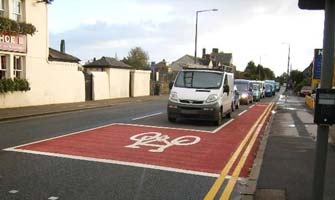
B
C
D
Correct Answer: C
Explanation: Some junctions have advanced stop lines with an area for cyclists to position themselves ahead of other traffic. You must stop at the first white line you reach. If you're unable to stop safely at the first line, you must stop at the second line, even though you'll be blocking the area reserved for cyclists.
Explanation: Some junctions have advanced stop lines with an area for cyclists to position themselves ahead of other traffic. You must stop at the first white line you reach. If you're unable to stop safely at the first line, you must stop at the second line, even though you'll be blocking the area reserved for cyclists.
Correct Answer: A
Explanation: This sign prohibits all motor vehicles. Only pedal cycles may pass it. However, a black-and-white plate underneath the sign may give exemptions; for example, 'except buses' or 'except for access'.
Explanation: This sign prohibits all motor vehicles. Only pedal cycles may pass it. However, a black-and-white plate underneath the sign may give exemptions; for example, 'except buses' or 'except for access'.
88. What should you advise your student if they ask you about the meaning of this sign?
Mark one answer
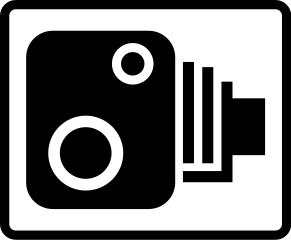
B
C
D
Correct Answer: D
Explanation: This sign reminds all road users that they're entering an area where cameras will monitor traffic regulations. This could include traffic-light cameras and bus-lane cameras, as well as the more common speed cameras.
Explanation: This sign reminds all road users that they're entering an area where cameras will monitor traffic regulations. This could include traffic-light cameras and bus-lane cameras, as well as the more common speed cameras.
89. What should you advise your student if they ask you about the meaning of this sign?
Mark one answer

B
C
D
Correct Answer: C
Explanation: Ring roads are designed to keep traffic away from town centres. Unless you need to visit the town centre, you should use the ring road, as this will help to avoid congestion and reduce your journey time.
Explanation: Ring roads are designed to keep traffic away from town centres. Unless you need to visit the town centre, you should use the ring road, as this will help to avoid congestion and reduce your journey time.
Correct Answer: B
Explanation: This curved arrow on the road indicates the direction that traffic should pass solid double white lines that are coming up. These arrows are also used on the approach to hatch markings and low arched bridges. Sometimes the arrow may curve to the right.
Explanation: This curved arrow on the road indicates the direction that traffic should pass solid double white lines that are coming up. These arrows are also used on the approach to hatch markings and low arched bridges. Sometimes the arrow may curve to the right.
Correct Answer: B
Explanation: The sign means 'Give way to oncoming vehicles', and it will be used where the road narrows; for example, where traffic-calming build-outs reduce the road width. It should not be confused with the blue rectangular sign that gives priority in the other direction.
Explanation: The sign means 'Give way to oncoming vehicles', and it will be used where the road narrows; for example, where traffic-calming build-outs reduce the road width. It should not be confused with the blue rectangular sign that gives priority in the other direction.
Correct Answer: D
Explanation: If you're involved in a collision that causes damage or injury to any other person, vehicle, animal or property, by law you must stop. Give your name, the vehicle owner's name and address, and the vehicle's registration number to anyone who has reasonable grounds for requiring them.
Explanation: If you're involved in a collision that causes damage or injury to any other person, vehicle, animal or property, by law you must stop. Give your name, the vehicle owner's name and address, and the vehicle's registration number to anyone who has reasonable grounds for requiring them.
93. Where should the beam coming from your headlights fall when travelling behind another vehicle in the night?
Mark one answer
B
C
D
Correct Answer: C
Explanation: Following too closely behind another vehicle at night may dazzle the driver. If you drop back, your headlight beam will fall short of the vehicle and so avoid dazzle.
Explanation: Following too closely behind another vehicle at night may dazzle the driver. If you drop back, your headlight beam will fall short of the vehicle and so avoid dazzle.
Correct Answer: A
Explanation: At a pelican crossing, there's a phase where the amber light flashes. This will show after the red light and gives pedestrians time to finish crossing safely. For drivers, the flashing amber light means they may drive on if the crossing is completely clear, but they must wait if pedestrians are still on the crossing.
Explanation: At a pelican crossing, there's a phase where the amber light flashes. This will show after the red light and gives pedestrians time to finish crossing safely. For drivers, the flashing amber light means they may drive on if the crossing is completely clear, but they must wait if pedestrians are still on the crossing.
Correct Answer: A
Explanation: In heavy rain, the road will be wet and there may be pooling surface water. This will reduce the grip the tyres have on the road and will at least double the distance it takes to stop. Take this increased stopping distance into account while driving. Double the separation distance you'd leave in dry conditions.
Explanation: In heavy rain, the road will be wet and there may be pooling surface water. This will reduce the grip the tyres have on the road and will at least double the distance it takes to stop. Take this increased stopping distance into account while driving. Double the separation distance you'd leave in dry conditions.
96. What's the maximum authorised mass (the total weight of the vehicle plus the maximum load it can carry safely) of a category B vehicle?
Mark one answer
B
C
D
Correct Answer: B
Explanation: Any more weight than this will take the vehicle into a different category, therefore making it unsuitable for a category B driving test.
Explanation: Any more weight than this will take the vehicle into a different category, therefore making it unsuitable for a category B driving test.
Correct Answer: A
Explanation: An incorrectly adjusted head restraint will offer reduced protection against whiplash injury. When adjusting the head restraint, set it so that it's at least as high as the eyes or top of the ears.
Explanation: An incorrectly adjusted head restraint will offer reduced protection against whiplash injury. When adjusting the head restraint, set it so that it's at least as high as the eyes or top of the ears.
98. What should you do if a bag falls from your roof rack while driving on the motorway?
Mark one answer
B
C
D
Correct Answer: C
Explanation: Drivers shouldn't try to retrieve anything from a motorway. The danger from, and to, passing traffic caused by someone on the carriageway shouldn't be underestimated. The recommended course of action is to go to the next emergency telephone and report the incident to the control centre.
Explanation: Drivers shouldn't try to retrieve anything from a motorway. The danger from, and to, passing traffic caused by someone on the carriageway shouldn't be underestimated. The recommended course of action is to go to the next emergency telephone and report the incident to the control centre.
99. What can a driving test candidate do if they feel their examination was carried out improperly?
Mark one answer
B
C
D
Correct Answer: C
Explanation: It must be appreciated that the examiner's decision can't be changed. However, if the candidate believes that the test wasn't conducted properly, they have the right to appeal to the Magistrates' Court in England and Wales or the Sheriff's Court in Scotland.
Explanation: It must be appreciated that the examiner's decision can't be changed. However, if the candidate believes that the test wasn't conducted properly, they have the right to appeal to the Magistrates' Court in England and Wales or the Sheriff's Court in Scotland.
100. How does ABS help to keep you in control of your vehicle when emergency braking?
Mark one answer
B
C
D
Correct Answer: C
Explanation: An anti-lock braking system (ABS) prevents the wheels from locking, so you can continue to steer the vehicle during heavy braking. ABS doesn't replace the need to plan well ahead and brake smoothly and progressively.
Explanation: An anti-lock braking system (ABS) prevents the wheels from locking, so you can continue to steer the vehicle during heavy braking. ABS doesn't replace the need to plan well ahead and brake smoothly and progressively.



